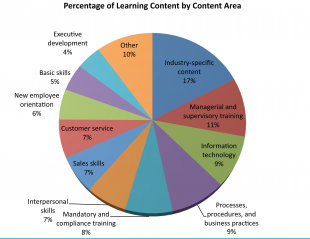What Kind of eLearning Courses Are Companies Looking For?


Just before Thanksgiving, the American Society for Training & Development released the 2010 State of the Industry Report, a fantastic resource chock full of information on the corporate learning and professional development marketplace. Did you know, for example, that U.S. companies spent more than $125 billion on learning and development activities in 2009? That’s billion with a b. More than 36% of those learning hours will be delivered through some kind of technology. That’s where we come in.
The report has one particularly useful data set for OpenSesame sellers: The breakdown of learning content sales by subject. These data reveal the highest priorities for the corporate training marketplace by delineating the subject areas where companies are seeking affordable and effective elearning courses to strengthen their workforce.
If you are an elearning seller identifying the courses in your library that will reach the widest possible audience in the OpenSesame marketplace, consult these data for insight into the types of courses that elearning buyers want to buy:
· Profession- or industry-specific content: 17.2% of formal learning hours;
· Managerial and supervisory training: 10.4% of formal learning hours;
· Information technology and systems: 9.3% of formal learning hours;
· Processes, procedures, and business practices: 9.2% of formal learning hours;
· Mandatory and compliance training: 7.8% of formal learning hours;
· Interpersonal skills: 6.8% of formal learning hours;
· Sales: 6.7% of formal learning hours;
· Customer service: 6.8% of formal learning hours;
· New employee orientation: 5.4% of formal learning hours;
· Basic skills: 4.8% of formal learning hours;
· Executive development: 4.4% of formal learning hours; and
· Other (such as specific product knowledge): 10% of formal learning hours.
Some of these subject areas, like new employee orientation or specific product knowledge, will require bespoke courses with company-specific content. Other categories, however, represent opportunities for an excellent seller to capture the market for a widespread training need. For example, the general principles of customer service are as appropriate for a software company as they are for a grocery store. If your course is the most effective course at engaging learners in understanding what customers want and how to reach them, you’ll reach a wide marketplace of willing purchasers.
Finally, remember that these data reflect the courses that companies purchased last year. The real winners in the elearning marketplace will be the course developers who can anticipate what new kinds of courses companies will purchase next year.



